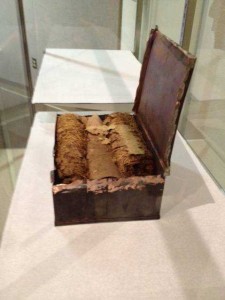by Jack
 In 1925 the California Historical Society placed a time capsule filled with artifacts significant to them, near a pathway to the Bidwell Mansion. The capsule, actually a copper box about the size of a shoe box, was sealed shut by soldering until it was air tight. There it lay, encased in a yard of concrete, until several weeks ago when workers moving the concrete block realized it contained a time capsule. The copper box was chipped out of the concrete and moved inside the Mansion’s visitor’s center to be opened later.
In 1925 the California Historical Society placed a time capsule filled with artifacts significant to them, near a pathway to the Bidwell Mansion. The capsule, actually a copper box about the size of a shoe box, was sealed shut by soldering until it was air tight. There it lay, encased in a yard of concrete, until several weeks ago when workers moving the concrete block realized it contained a time capsule. The copper box was chipped out of the concrete and moved inside the Mansion’s visitor’s center to be opened later.
Today was the day. On this otherwise dreary cold, wet November morning, at exactly 10:30 am, a crowd of about 120 people gathered to witness the much anticipated opening of the time capsule by museum personal.
The museum staff had elected not to used a soldering iron for fear of damaging the contents and instead chose a more laborious process. They cut away the solder with a high speed Dremel saw which damaged the copper box quite a bit, but it did not disturb the contents. Then the box was carefully pried open before the room of eager onlookers.
And what treasure awaited them? Well, we still don’t know! Because whatever it was, was carefully wrapped in three cylindrical objects in padding similar to the bedding found in a water cooler pad (strings of wood) and that was wrapped in heavy paper. The paper had deteriorated away on the outer two containers, but the paper on middle container was still quite visible, being about 80% in tact . The staff preferred not to damage the delicate wrapping material before peaking inside with either an MRI or an XRAY machine. The later seems the most prudent since we have no idea if the wrapping contain metal. Metal would be subject to severe magnetic force in the MRI.
So, for the time being the mystery of the time capsule must wait a little longer. The crowd had to be content with looking at the three wrapped tubes of whatever was inside - the museum staff said they weighed very little.
The question on our minds is, what would someone in the local Historical Society of 1925 think was so valuable that it should be preserved for posterity in these three light padded tubes measuring only 4 inches by 14 inches? More to follow.

How do we know the capsule was supposed to be opened now? When did the people who made it want it opened? Who said the people who opened it were supposed to open it? Isn’t there some law for all this? (If not I would think the liberals would be up in arms.)
The question on our minds is, what would someone in the local Historical Society of 1925 think was so valuable that it should be preserved for posterity in these three light padded tubes measuring only 4 inches by 14 inches?
Heck Jack, I bet you already know. I bet you figured it out. Don’t think we don’t know what you think we don’t know! Now, why don’t you let us in on the answer?
Bob, all I can tell you is that my son and I both arrived at the same conclusion. Think about it, what is about 10-12 inches long, fairly light, about 2.5 inches in diameter, very fragile that it needed good packing and there would be three of them of equal size?
Answer: 3 Edison gramophone cylinders. Office equipment of that period were still using them to record voices although the 78 rpm record was available you generally couldn’t record on it. That’s our guess anyway. I think it would pretty neat to hear voices from the past talk about Chico. Maybe hear some school kids talking or singing. That would be a great gift for a time capsule.
As to when it was supposed to be opened, nope, no law against opening it. This is close to the right time…typically they last about 100 years before being opened.